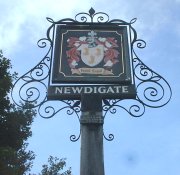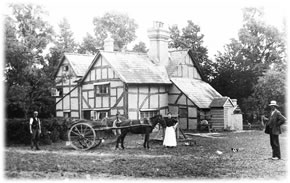|
 Newdigate lies mid way between Dorking, Reigate and Horsham on the clay of the Surrey Weald. The eighteenth-century turnpike did not pass through the village so only the most intrepid travellers ever found their way to Newdigate. Thus until the late 1800s the whole area was imbued with a mysterious and somewhat backward atmosphere. Saxon swineherds were the first inhabitants, followed by the Norman landowners, the de Warenne family. A successful social climber, one of their tenants took his name from that of the village; William de Newdigate later became Sheriff of Surrey and Sussex Newdigate lies mid way between Dorking, Reigate and Horsham on the clay of the Surrey Weald. The eighteenth-century turnpike did not pass through the village so only the most intrepid travellers ever found their way to Newdigate. Thus until the late 1800s the whole area was imbued with a mysterious and somewhat backward atmosphere. Saxon swineherds were the first inhabitants, followed by the Norman landowners, the de Warenne family. A successful social climber, one of their tenants took his name from that of the village; William de Newdigate later became Sheriff of Surrey and Sussex . .
Tanhouse Farm, the home of the Holt family, c.1910.
The village became prosperous when the medieval iron industry developed in the Weald and particularly at nearby Ewood, but when the foundries moved to the North in the seventeenth century people moved away and the village fell into decline. By 1794 the curate, Thomas Duncomb, had been moved to comment that 'in every respect Newdigate is so unfavourably situated, that it is the last place in the world I would choose to farm in.' In the late-nineteenth century people who had made their wealth elsewhere bought up land and several large houses and estates were established. This brought in new employment, more houses were built and the village continued developing to the present day.
John Callcut has lived in Newdigate with his wife and two sons since 1974 and lives in a converted barn opposite the church (or next to the Six Bells pub depending upon who you are speaking to). He was the co-author and illustrator of Newdigate - A Village Guide and is currently the editor of the Newdigate Society Magazine. In the compilation of this volume John has drawn upon the considerable archives of the Newdigate Society. Founded in 1984 following an initiative from the late Charles Thompson and George Green, the group today boasts a membership of nearly 200 people. John has also spent much time liaising closely with local historian and author, Joyce Banks, and other members of the Society. One of the joys of this publication will be the opportunity to see well over 300 wonderful photographs, most of which usually remain in albums stored in cupboards away from the public view.
|
|